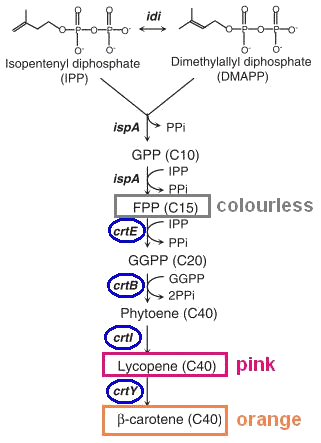Team:Cambridge/Project/Carotenoids/Introduction
From 2009.igem.org
(→Carotenoid Pigment) |
(→Carotenoid Pigment) |
||
| Line 12: | Line 12: | ||
{{Template:Cambridgetemplatebottom}} | {{Template:Cambridgetemplatebottom}} | ||
| - | |||
== Introduction == | == Introduction == | ||
| + | |||
| + | [[Team:Cambridge/Project/Carotenoids/Introduction |Introduction]] | ||
Carotenoids are organic pigments naturally present in plants, algae and some bacteria. There are more than 600 carotenoids, which can be categorised into xanthophylls (hydrocarbons containing oxygen element) and carotenes (hydrocarbons containing no oxygen). Carotenoids perform a range of functions, including light energy absorption, protection against photo-damage, acting as antioxidants, and as precursor to other organic compounds. In human, for example, beta-carotene is the precursor to vitamin A. | Carotenoids are organic pigments naturally present in plants, algae and some bacteria. There are more than 600 carotenoids, which can be categorised into xanthophylls (hydrocarbons containing oxygen element) and carotenes (hydrocarbons containing no oxygen). Carotenoids perform a range of functions, including light energy absorption, protection against photo-damage, acting as antioxidants, and as precursor to other organic compounds. In human, for example, beta-carotene is the precursor to vitamin A. | ||
Revision as of 12:17, 2 September 2009
Categories :
Project :
-
Overview
Sensitivity Tuner
--- Characterisation
--- Modelling
Colour Generators
--- Carotenoids (Orange/Red)
--- Melanin (Brown)
--- Violacein (Purple/Green)
The Future
Safety
Notebook :
Team Logistics :
Carotenoid Pigment
-
Introduction
Previous Research
Our Action Plan
Result Analysis
Reference
Introduction
Introduction
Carotenoids are organic pigments naturally present in plants, algae and some bacteria. There are more than 600 carotenoids, which can be categorised into xanthophylls (hydrocarbons containing oxygen element) and carotenes (hydrocarbons containing no oxygen). Carotenoids perform a range of functions, including light energy absorption, protection against photo-damage, acting as antioxidants, and as precursor to other organic compounds. In human, for example, beta-carotene is the precursor to vitamin A.
Part of the carotenoid biosynthesis pathway is shown below (figure adopted from iGEM 2007 Team Edinburgh):
Some of the intermediates in the above pathways are coloured, e.g. lycopene (red), beta-carotene (orange), and zeaxanthin (yellow). The enzymes involved in the biosynthetic pathway are CrtE, CrtB, CrtI, CrtY, and CrtZ. Since our team aims to use different colour pigments as signal output, the above pathway can be incorporated in our design of colour production.
 "
"
